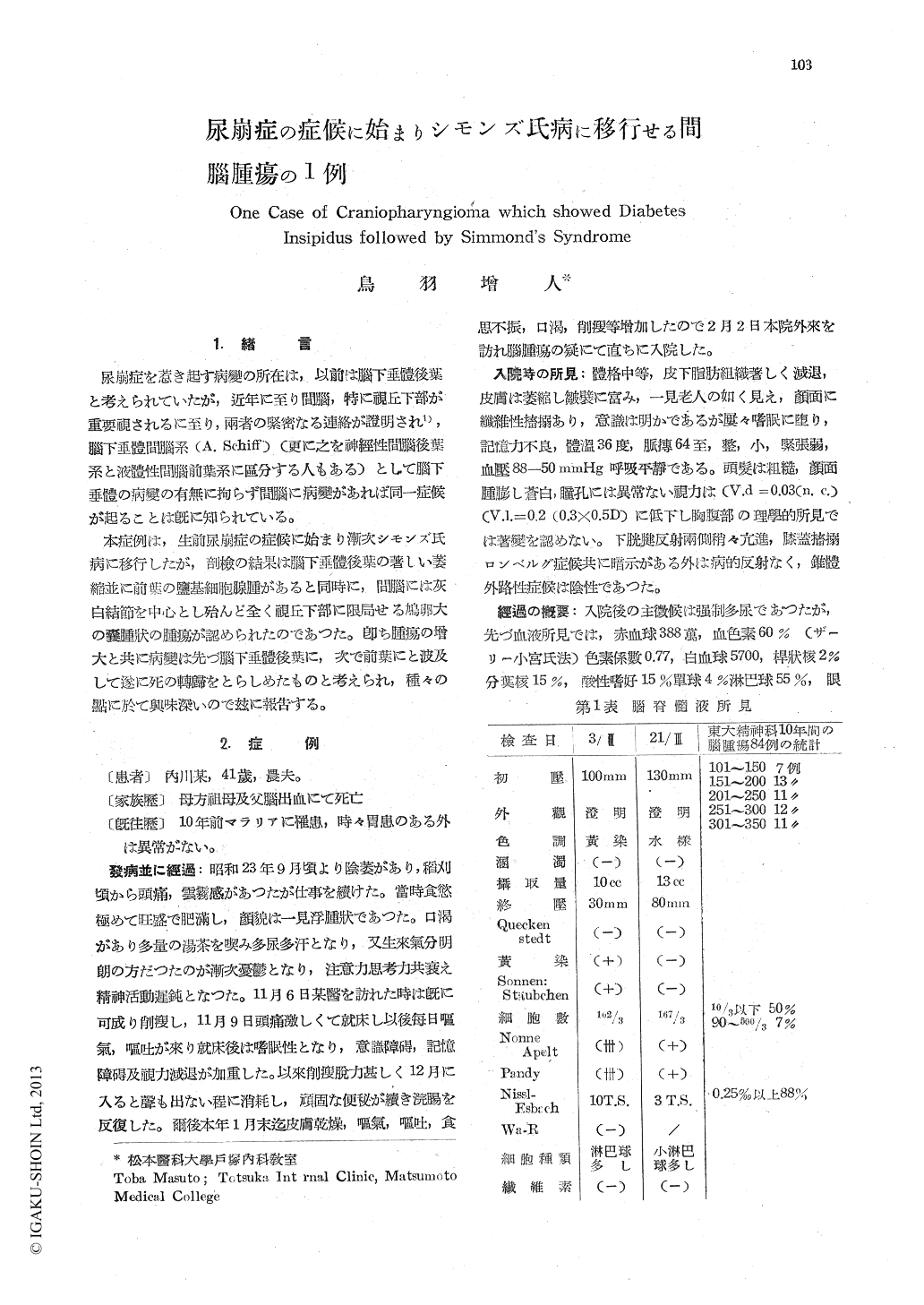Japanese
English
- 有料閲覧
- Abstract 文献概要
- 1ページ目 Look Inside
1.緒言
尿崩症を惹き起す病變の所在は,以前は腦下垂體後葉と考えられていたが,近年に至り間腦,特に視丘下部が重要視されるに至り,兩者の緊密なる連絡が證明され1),腦下垂體間腦系(A.Schiff)(更に之を神經性間腦後葉系と液體性間腦前葉系に區分する人もある)として腦下垂體の病變の有無に拘らず間腦に病變があれば同一症候が起ることは既に知らられている。
本症例は,生前尿崩症の症候に始まり漸次シモンズ氏病に移行したが,剖檢の結果は腦下垂體後葉の著しい萎縮並に前葉の鹽基細胞腺腫があると同時に,間腦には灰白結節を中心とし殆んど全く視丘下部に限局せる鳩卵大の嚢腫状の腫瘍が認められたのであつた。即ち腫瘍の増大と共に病變は先づ脳下垂體後葉に,次で前葉にと波及して遂に死の轉歸をとらしめたものと考えられ,種々の點に於て興味深いので茲に報告する。
It has recently been made clear that the lesion of the lower diencephalic region causes diabetes insipidus, even if neurehypohysis is normal. In this case, at the beginning of disease, symptoms were that of diabetes insipidus which was accompanied by disturbance of consciousness, and then changed to that of Simmonds's disease. So I thought that the lesion was at first situated in the diencephalon then spreaded gradually to the neurohypophysis, and at last to the adeno-hypophysis. This was justified by autopsy findings the lesion was cranio-pharyngioma that was limited to the hypothala-mic region.
This patient was a farmer, of 41 years. At the beginning of this disease, headache, thirst, poly-uria, hyperhydrosis appeard, and gradually melan-choly, tardiness of mind, emaciation, sopor accompa-nied them, moreover disturbance of consciousness and fiurred visions obstinate constipation sometimes vomiting appeard. He came to the hospital 5man-ths after the onset, at the time of his admission, his vision was nearly lost with bitemporal hemi-anopia. and polyuria, and decline of concentrating power his urine, showed characteristies of diabetes insipidus, the injection of some doses of the hor-mone of neuro-hypophysis was effective while the hormone of adenchypophipis aggravated the symp-toms. which was again improved when tho hormone of adenohypophysis was discarded the hormone of neurohyphphysis was contiuned 11/2 month after his entrance, the symptoms, of cachxnia pituitaria (Simmond's syndrome) appeared, since then the hormone of neurohypophysis gave no effect.
This showed that the lesion had been spreaded from neurohypophysis to adeno-hypophysis. At this time, the hormone of Adensohypophysis was given with remarkable effects.
However, his severe emaciation developed gradu-ally, and died after 3months hospitalization and lmonth interval after discharge.
The autopsy revealed the hypophysis was enlarg-ed slightly, due to increase of the basophile cells of the adenohypophysis and the neurohypophysis was nearly totally destroyed by craniophbryngioma.

Copyright © 1951, Igaku-Shoin Ltd. All rights reserved.


